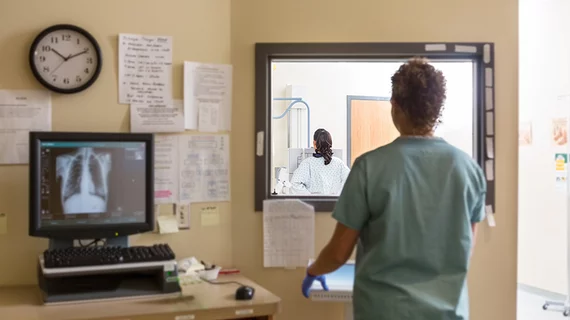Normal chest x-ray ‘no guarantee’ a patient is COVID-free, urgent care providers say
A group of urgent care providers are casting further doubts this week about the use of chest x-rays to assess patients with possible COVID-19.
In a study set to be published in the Journal of Urgent Care Medicine, experts reported that 89% of those confirmed to have the disease displayed normal or mildly abnormal CXRs. While some studies have found that chest CT has higher sensitivity for identifying COVID symptoms, such systems are often not available in ambulatory settings, authors noted.
“As our collective understanding of the COVID-19 pandemic—how it’s spread, who is most at risk and how to check its progression—continues to evolve, one thing that has been lacking is a solid data set derived from clinical experience,” Publisher Stuart Williams said in a statement. “JUCM took a step towards rectifying this shortfall by publishing this comprehensive study, which is a substantial contribution to the growing body of knowledge of COVID-19.”
To reach their conclusions, lead author Michael Weinstock, MD, and colleagues tasked a team of 11 board-certified radiologists with reviewing 636 chest x-rays. Images were gathered in New York last month at a large urgent care network, with all patients confirmed to have the virus using polymerase chain reaction tests.
All told, the team of radiologists reported that 371 (or 58%) of images appeared normal, while the other 371 were slightly abnormal (42%). Of the latter group, 195 demonstrated mild disease, 65 moderate disease and five severe disease. Interstitial changes and ground glass opacities were the most predominant findings in 24% and 19% of abnormal images, respectively.
Weinstock—a professor of emergency medicine at Ohio State University—and colleagues noted that rads were informed of the testing results beforehand, which may have resulted in bias.
“Although the radiologists were instructed not to let the initial CXR read, or knowledge of COVID-19 diagnosis, influence their interpretation, they were not blinded to this information and we cannot rule out that it might have had an impact on their classifications. The shift to classify more CXRs as abnormal during the re-read suggest that this might be so,” the team wrote.
“Chest X-Ray Findings in 636 Ambulatory Patients with COVID-19 Presenting to an Urgent Care Center: A Normal Chest X-Ray Is no Guarantee” is available for free here ahead of it publishing in May’s JUMC.

